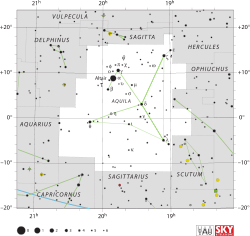Epsilon Aquilae

| |
| Observation data Epoch J2000 Equinox J2000 | |
|---|---|
| Constellation | Aquila |
| Right ascension | 18h 59m 37.35872s[1] |
| Declination | +15° 04′ 05.8871″[1] |
| Apparent magnitude (V) | 4.02[2] |
| Characteristics | |
| Spectral type | K1 III[3] |
| U−B color index | +1.04[2] |
| B−V color index | +1.08[2] |
| R−I color index | 0.52 |
| Astrometry | |
| Radial velocity (Rv) | –48[4] km/s |
| Proper motion (μ) | RA: –50.75[1] mas/yr Dec.: –72.36[1] mas/yr |
| Parallax (π) | 21.05 ± 0.70[1] mas |
| Distance | 155 ± 5 ly (48 ± 2 pc) |
| Absolute bolometric magnitude (Mbol) | +0.30[5] |
| Details | |
| ε Aql A | |
| Mass | 2.1+0.4 −0.2[6] M☉ |
| Radius | 10.14±0.70[7] R☉ |
| Luminosity | 54±5[7] L☉ |
| Surface gravity (log g) | 2.91[7] cgs |
| Temperature | 4760[7] K |
| Metallicity [Fe/H] | 0.00[7] dex |
| Rotational velocity (v sin i) | 4.4[8] km/s |
| ε Aql B | |
| Mass | 0.47±0.05[6] M☉ |
| Other designations | |
| Data sources: | |
| Hipparcos Catalogue, CCDM (2002), Bright Star Catalogue (5th rev. ed.) | |
Epsilon Aquilae (ε Aql, ε Aquilae) is the Bayer designation for a binary star in the equatorial constellation of Aquila. It has an apparent visual magnitude of 4.02[2] and is visible to the naked eye. Based upon an annual parallax of 21.05 mas,[1] Epsilon Aquilae lies at a distance of approximately 155 light-years (48 parsecs) from Earth. This is a spectroscopic binary system.[6] The pair orbit each other over a period of 1,271 days (3.5 years) with an eccentricity of 0.27.[10]
It has the traditional name Deneb el Okab, from an Arabic term ذنب العقاب ðanab al-cuqāb meaning "the tail of the eagle", and the Mandarin names Woo and Yuë, derived from and represent the state Wu (吳), an old state was located at the mouth of the Yangtze River, and Yue (越), an old state in Zhejiang province[11] (together with 19 Capricorni in Twelve States asterism). According to the R.H. Allen's works, it shares names with ζ Aquilae.[12] Epsilon Aquilae is more precisely called Deneb el Okab Borealis, because is situated to the north of Zeta Aquilae, which can therefore be called Deneb el Okab Australis.
The primary component of this system is an evolved giant star with a stellar classification of K1 III.[3] It has more than double[6] the mass of the Sun and has expanded to ten[7] times the Sun's radius. It shines with 54–fold the Sun's luminosity, which is being radiated from its outer envelope at an effective temperature of 4,760 K.[7] At this heat, it glows with the orange-hue of a K-type star.[13] This has been designated a barium star, meaning its atmosphere is extremely enriched with barium and other heavy elements. However, this is disputed, with astronomer Andrew McWilliam (1990) finding normal abundances from an s-process.[6]
References
- 1 2 3 4 5 6 van Leeuwen, F. (November 2007), "Validation of the new Hipparcos reduction", Astronomy and Astrophysics, 474 (2): 653–664, arXiv:0708.1752
 , Bibcode:2007A&A...474..653V, doi:10.1051/0004-6361:20078357.
, Bibcode:2007A&A...474..653V, doi:10.1051/0004-6361:20078357. - 1 2 3 4 Johnson, H. L.; et al. (1966), "UBVRIJKL photometry of the bright stars", Communications of the Lunar and Planetary Laboratory, 4 (99), Bibcode:1966CoLPL...4...99J.
- 1 2 Roman, Nancy G. (July 1952), "The Spectra of the Bright Stars of Types F5-K5", Astrophysical Journal, 116: 122, Bibcode:1952ApJ...116..122R, doi:10.1086/145598.
- ↑ Wilson, Ralph Elmer (1953), General Catalogue of Stellar Radial Velocities, Washington: Carnegie Institution of Washington, Bibcode:1953GCRV..C......0W.
- ↑ Luck, R. Earle; Heiter, Ulrike (June 2007), "Giants in the Local Region", The Astronomical Journal, 133 (6): 2464–2486, Bibcode:2007AJ....133.2464L, doi:10.1086/513194.
- 1 2 3 4 5 Pourbaix, D.; Boffin, H. M. J. (February 2003), "Reprocessing the Hipparcos Intermediate Astrometric Data of spectroscopic binaries. II. Systems with a giant component", Astronomy and Astrophysics, 398: 1163–1177, arXiv:astro-ph/0211483
 , Bibcode:2003A&A...398.1163P, doi:10.1051/0004-6361:20021736.
, Bibcode:2003A&A...398.1163P, doi:10.1051/0004-6361:20021736. - 1 2 3 4 5 6 7 Piau, L.; et al. (February 2011), "Surface convection and red-giant radius measurements", Astronomy and Astrophysics, 526: A100, arXiv:1010.3649
 , Bibcode:2011A&A...526A.100P, doi:10.1051/0004-6361/201014442.
, Bibcode:2011A&A...526A.100P, doi:10.1051/0004-6361/201014442. - ↑ Massarotti, Alessandro; et al. (January 2008), "Rotational and Radial Velocities for a Sample of 761 HIPPARCOS Giants and the Role of Binarity", The Astronomical Journal, 135 (1): 209–231, Bibcode:2008AJ....135..209M, doi:10.1088/0004-6256/135/1/209.
- ↑ "eps Aql -- Star", SIMBAD Astronomical Database, Centre de Données astronomiques de Strasbourg, retrieved 2011-12-29
- ↑ Eggleton, P. P.; Tokovinin, A. A. (September 2008), "A catalogue of multiplicity among bright stellar systems", Monthly Notices of the Royal Astronomical Society, 389 (2): 869–879, arXiv:0806.2878
 , Bibcode:2008MNRAS.389..869E, doi:10.1111/j.1365-2966.2008.13596.x.
, Bibcode:2008MNRAS.389..869E, doi:10.1111/j.1365-2966.2008.13596.x. - ↑ (Chinese) English-Chinese Glossary of Chinese Star Regions, Asterisms and Star Name, Hong Kong Space Museum. Accessed on line November 23, 2010.
- ↑ Star Names - R.H.Allen p.61
- ↑ "The Colour of Stars", Australia Telescope, Outreach and Education, Commonwealth Scientific and Industrial Research Organisation, December 21, 2004, retrieved 2012-01-16.